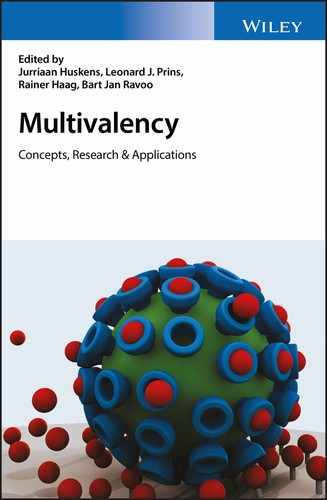Foreword
Scientific challenges come and go; only a few of them remain for a long time. Multivalency is one of those research topics that has been prominent for many years, as this intriguing phenomenon is of profound importance in many biological processes as well as very difficult to understand and mimic. Personally, I became intrigued by the challenge of multivalency when our group entered the field of dendrimers in 1990. The controlled number of end groups – 4, 8, 16, 32, and 64 amines of the polypropylene imines – opened many opportunities for us to explore the controlled use of multiple interactions. However, our ideas were more simple than our experiments in making full use of the potential of multivalency; many of them remained in the realm of dreaming. The broad potential of multivalency as well as its complex mode of action was beautifully illustrated by George Whitesides and coworkers [1] in the seminal Angewandte Chemie review paper in 1998. Their review initiated a world‐wide search for synthetic mimics of these highly effective natural systems, a search that turned out to be long lasting.
Nature uses both similar interactions (homovalency) and different interactions (heterovalency) to control selectivity and specificity, even leading to ultra‐sensitivity. Beautiful examples are found in substrate–cell interactions and immunology. Ever since this elegant mechanism and its importance in biological systems has been recognized, chemists have been intrigued to fully understand the enhancement factors obtained in binding multiple weak interactions through multivalency. Artificial systems are designed, synthesized, and studied, while a number of applications are proposed. Multivalent medication can have lower toxicity while simultaneously having higher medical efficacy.
Although the knowledge on the modus operandi of these systems has increased significantly in time and the systems synthesized have become more active, the full potential of the proposed applications remains. Hence, a number of challenging questions need to be answered before the potential of this intriguing concept can be explored. How to design the ideal structure to arrive at the theoretical maximum avidity and how to obtain scaling with valency are just a few of these intriguing questions. Theoretical and experimental studies of multivalent systems have revealed several design parameters that are critical in obtaining effective multivalent constructs. Next to the binding affinity, linker flexibility plays an important role, as rigid linkers require extremely precise ligand positioning to obtain high binding affinities and selectivity, while flexible linkers offer more freedom in molecular design at the cost of lower affinity and selectivity. Furthermore, additional competing equilibria can be used to enhance binding selectivity or to steer an assembly towards a preferred state. However, the complexity of all these effects and their interference makes the field one of the most challenging areas in the molecular sciences.
Therefore, it is great to see that four outstanding scientists have edited a book on the intriguing topic of multivalent interactions. It is a book full of excellent chapters written by the most active experts in the field, covering all aspects of multivalent interactions with special emphasis on theory, synthesis, surfaces, chemical biology, and supramolecular chemistry. I am convinced that this book will be a great asset for all active in this intriguing field of science.
E.W. Meijer
Reference
- 1 Mammen, M., Choi, S.-K., Whitesides, G. M. Polyvalent interactions in biological systems: Implications for design and use of multivalent ligands and inhibitors. Angew. Chem. Int. Ed. 1998, 37, 2754–2794.
